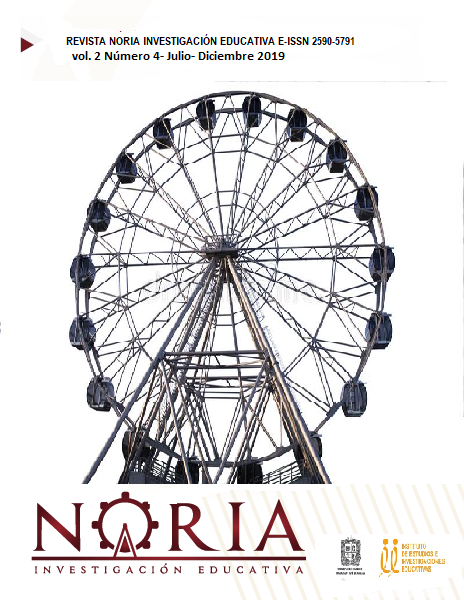DOI:
https://doi.org/10.14483/25905791.16353Publicado:
2019-07-31Número:
Vol. 2 Núm. 4 (2019): Revista Noria Investigación EducativaSección:
Investigación e InnovaciónEstudio de modelos propuestos para el nervio mediano sano y con síndrome de túnel carpiano
Study of proposed models for the healthy median nerve and with carpal tunnel syndrome
Palabras clave:
Nervio, potenciales de acción, mielina, túnel del carpo (es).Descargas
Resumen (es)
En este documento se muestra de forma detallada la revisión de modelos teóricos para el nervio mediano, observando el estado de un nervio con mielina y sin mielina, con las variables que cada autor genera para profundizar en los análisis que exponen, para de esta forma entrar a detallar los parámetros más relevantes que se observan en la literatura con las causas probables de la generación del síndrome del túnel carpiano en la sociedad laboral, de igual forma se muestra de forma resumida la parte anatómica que recorre el nervio mediano, para finalmente concluir que los parámetros de mayor relevancia son la frecuencia por los efectos capacitivos, la intensidad de corriente, la duración, latencia y velocidad de conducción. Trabajo realizado en el grupo de investigación LIDER de la Universidad Distrital Francisco José de Caldas.
Referencias
Balbastre Tejedor, M., Andani Cervera, J., Garrido Lahiguera, R., & López Ferreres, A. (2016). Análisis de factores de riesgo laborales y no laborales en Síndrome de Túnel Carpiano (STC) mediante análisis bivariante y multivariante. Revista de la Asociación Española de Especialistas en Medicina del Trabajo, 25(3), 126-141.
Bollini, C. A., & Cacheiro, F. (2004). Estimulación nerviosa periférica (neurolocalización). Rev. argent. anestesiol, 399-409.
Butikofer, R. y Lawrence, PD (1979). Estimulación electrocutánea del nervio II: selección de la forma de onda del estímulo. IEEE Transactions on Biomedical Engineering , (2), 69-75.
Choi, C. T., & Sun, S. H. (2012). Simulation of axon activation by electrical stimulation—Applying alternating-direction-implicit finite-difference time-domain method. IEEE transactions on magnetics, 48(2), 639-642.
De Bruin, P (1952). A quantitative description of membrane current and its application to conduction and excitation in nerve,Philos. en Theol. Fac. der Ned. Jezuieten, vol. 117, pp. 500–544.
Fitzhugh, R. (1962). Computation of impulse initiation and saltatory conduction in a myelinated nerve fiber. Biophysical journal, 2(1), 11-21.
Frankenhaeuser, B., & Huxley, A. F. (1964). The action potential in the myelinated nerve fibre of Xenopus laevis as computed on the basis of voltage clamp data. The Journal of Physiology, 171(2), 302-315.
García-Pinzón, J., Mendoza, L., & Flórez, E. (2015). Control de brazo electrónico usando señales electromiográficas. Revista Facultad de Ingeniería, 24(39), 71-84. https://doi.org/10.19053/01211129.3554
Goldman, L., & Albus, J. S. (1968). Computation of impulse conduction in myelinated fibers; theoretical basis of the velocity-diameter relation. Biophysical journal, 8(5), 596-607.
Hagberg, M., Morgenstern, H., & Kelsh, M. (1992). Impact of occupations and job tasks on the prevalence of carpal tunnel syndrome. Scandinavian Journal of work, Environment & health, 337-345.
Hu, W., Li, K., Su, Z., Hou, Z., Li, Y., & Wang, X. (2016,). Effects of carpal tunnel syndrome on intrinsic muscle electromyograms during precision grip. In 2016 9th International Congress on Image and Signal Processing, BioMedical Engineering and Informatics (CISP-BMEI) (pp. 1691-1695).
Kajimoto, H., Kawakami, N., & Tachi, S. (2002). Optimal design method for selective nerve stimulation and its application to electrocutaneous display. In Proceedings 10th Symposium on Haptic Interfaces for Virtual Environment and Teleoperator Systems. HAPTICS 2002 (pp. 303-310).
Kao, S. Y. (2003). Carpal tunnel syndrome as an occupational disease. The journal of the American board of family practice, 16(6), 533-542.
Kozak, A., Schedlbauer, G., Wirth, T., Euler, U., Westermann, C., & Nienhaus, A. (2015). Association between work-related biomechanical risk factors and the occurrence of carpal tunnel syndrome: an overview of systematic reviews and a meta-analysis of current research. BMC musculoskeletal disorders, 16(1), 231.
McNeal, DR (1976). Análisis de un modelo para la excitación del nervio mielinizado. IEEE Transactions on Biomedical Engineering , (4), 329-337.
Moreno-Cueva, L., Peña-Cortés, C., & González-Sepúlveda, H. (2014). Integración de un sistema de Neurosignals para detectar expresiones humanas en el análisis de material multimedia. Revista Facultad de Ingeniería , 24 (38), 29-40. https://doi.org/10.19053/01211129.3156
Nieto Duran, J. D., Santos Quintero, L. F., Vargas Escobar, L. J., & Salinas, S. A. (2017). Geolocalización para pacientes con alzhéimer: una propuesta. Visión electrónica, 11(1), 40-44. https://doi.org/10.14483/22484728.12791
Pickard, WF (1966). Sobre la propagación del impulso nervioso por fibras meduladas y no meduladas. Revista de biología teórica , 11 (1), 30-45.
Reilly, J. P., Freeman, V. T., & Larkin, W. D. (1985). Sensory effects of transient electrical stimulation-evaluation with a neuroelectric model. IEEE transactions on biomedical engineering, (12), 1001-1011.
Riveros, A., Olave, E., & Sousa-Rodrigues, C. (2015). Relaciones entre Nervio Mediano y Musculo Pronador Redondo en la Región Cubital: Implicancias Anatomo-Clínicas. International Journal of Morphology, 33(4), 1448-1454.
Rodríguez López, C. (2017). Análisis ecográfico del deslizamiento del nervio mediano en pacientes con accidente cerebrovascular en comparación con un grupo control.
Sacré, P., Sarma, S. V., Guan, Y., & Anderson, W. S. (2015). Electrical neurostimulation for chronic pain: on selective relay of sensory neural activities in myelinated nerve fibers. In 2015 37th Annual International Conference of the IEEE Engineering in Medicine and Biology Society (EMBC) (pp. 4705-4708).
Sadashivaiah, V., Sacré, P., Guan, Y., Anderson, W. S., & Sarma, S. V. (2018). Studying the interactions in a mammalian nerve fiber: a functional modeling approach. In 2018 40th Annual International Conference of the IEEE Engineering in Medicine and Biology Society (EMBC) (pp. 3525-3528).
Sánchez, F. P. (2015). Calidad de Vida en el Trabajador con Síndrome del Túnel del Carpo: Una intersección entre aspectos de Salud y Laborales. Revista colombiana de Salud ocupacional, 5(1), 13-18.
Sánchez, J. A. D., Costa, J. L., Vallejo, R., & Torres, J. L. (2004). Lesión total del nervio mediano y función motora preservada de la mano. Acta Neurol Colomb, 20(3), 127-133.
Schoonhoven, R., Stegeman, D. F., & Van Oosterom, A. (1986). The Forward Problem in Electroneurography II: Comparson of Models. IEEE transactions on biomedical engineering, (3), 335-341.


